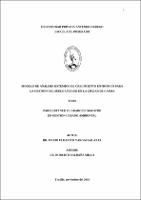Mostrar el registro sencillo del ítem
Modelo de análisis sistémico de crecimiento entrópico para la gestión del suelo urbano en la ciudad de Casma
| dc.contributor.advisor | Saldaña Milla, Roberto | |
| dc.contributor.author | Vargas Salazar, Mario Uldarico | |
| dc.creator | Vargas Salazar, Mario Uldarico | |
| dc.date.accessioned | 2017-09-01T13:49:53Z | |
| dc.date.available | 2017-09-01T13:49:53Z | |
| dc.date.issued | 2016 | |
| dc.identifier.uri | https://hdl.handle.net/20.500.12759/2911 | |
| dc.description.abstract | Es propósito del presente estudio, construir un “MODELO DE ANÁLISIS SISTÉMICO DE CRECIMIENTO ENTRÓPICO PARA LA GESTIÓN DEL SUELO URBANO EN LA CIUDAD DE CASMA”. Para mediante el análisis sistémico, explicar y comprender en forma científica, la relación causa-efecto que permiten al crecimiento entrópico y a la gestión empírica formal e informal, permanecer en el horizonte temporal. Para ello la metodología contempla cuatro momentos. Primero, identificó la esencia sistémico-cualitativa del crecimiento entrópico en su interacción con la gestión del suelo urbano, en la ciudad de Casma. Segundo, planteó la modelación como método y estrategia lógico-racional. Tercero, identificó la estructura sistémica del problema, marco teórico, y matriz de operacionalización de variables. Cuarto, los procesos de transformación del objeto de estudio, permitieron modelar todos los pasos del proceso transformativo, hasta llegar al modelo práctico de solución. Con el cual se cumple con el propósito de la investigación. En dicho contexto, la teoría de sistemas y la sistemo-dinámica, fueron herramientas integradoras para diseñar procesos y estrategias de modelación. Acompañada de las teorías valor del suelo y demográfica, y de la gestión por procesos. La modalidad crítico propositiva de la presente investigación, fue el eje metodológico transversal, que enriqueció la propuesta de análisis sistémico. Los procesos de transformación del objeto de estudio, generaron el modelo teórico-práctico, el modelo práctico de propuesta, y el modelo de análisis sistémico de crecimiento entrópico, para la gestión del suelo urbano en la ciudad de Casma, como producto final. Su organización funcional para uso práctico, ocurre al integrarse estructuralmente con el sistema de información geográfica ArcGIS 10.3, cuyo análisis con valoración de indicadores, arrojó tres productos de análisis valorado. a) Gestión de suelo valorado según dinámicas urbanas. b) Lotes urbanos con crecimiento entrópico valorado. c) Análisis gráfico comparativo, de crecimiento entrópico valorado con la gestión del suelo según dinámicas urbanas. Con lo cual se demostró el funcionamiento práctico del “Modelo” propuesto, su utilidad en la gestión del suelo urbano con crecimiento entrópico, y su excelente sinergia al integrarse con el ArcGIS. | es_PE |
| dc.description.abstract | It is the purpose of the present study, to build a ““MODEL OF ANALYSIS SYSTEMIC OF GROWTH ENTROPIC FOR THE MANAGEMENT of the GROUND URBAN IN THE CITY OF CASMA““. Through the systemic analysis, explain and understand in scientific form, the cause-effect relations that allow growth Entropic and formal and informal, empirical management remain on the time horizon. This methodology includes four times. First, it identified the systemic-qualitative essence of the growth entropic in its interaction with the management of urban land, in the city of Casma. Second, raised her modeling as a method and strategy rational. Third, it identified the systemic structure of the problem, theoretical framework, and array of operationalization of variables. Fourth, the processes of transformation of the object of study, allowed all steps of the process of transformative, until you reach the practical model of solution model. With which it complies with the purpose of the research. In said context, the theory of systems and the system-dynamic were tools integrators to design processes and strategies of modeling. Accompanied of the theories value of the soil and demographic, and of it management by processes. The mode critical purposeful of the present research, was the shaft methodological cross, that enriched the proposal of analysis systemic. The processes of transformation of the object of study, generated the theoretical and practical model, the practical of proposed model, and the model of analysis systemic of growth entropic, for it management of the soil urban in the city of Casma, as final product. His organization functional to use practical, takes place to integrate is structurally with the system of information geographic ArcGIS 10.3, whose analysis with assessment of indicators, threw three products of analysis valued. (a) Management of land valued according to urban dynamics. (b) Batch urban with growth entropic valued. (c) Comparative graphic analysis, of growth entropic valued with the management of the land according to urban dynamics. Which showed the practical functioning of the proposed ““model““, its usefulness in urban land with entropic growth management, and its excellent synergy to integrate with the ArcGIS. | en_US |
| dc.description.uri | Tesis | es_PE |
| dc.format | application/pdf | es_PE |
| dc.language.iso | spa | es_PE |
| dc.publisher | Universidad Privada Antenor Orrego | es_PE |
| dc.relation.ispartofseries | T_MAEST.ARQ_010 | |
| dc.rights | info:eu-repo/semantics/openAccess | es_PE |
| dc.rights.uri | https://creativecommons.org/licenses/by/4.0/ | es_PE |
| dc.source | Universidad Privada Antenor Orrego | es_PE |
| dc.source | Repositorio Institucional - UPAO | es_PE |
| dc.subject | Análisis sistémico | es_PE |
| dc.subject | Suelo urbano | es_PE |
| dc.title | Modelo de análisis sistémico de crecimiento entrópico para la gestión del suelo urbano en la ciudad de Casma | es_PE |
| dc.type | info:eu-repo/semantics/masterThesis | es_PE |
| thesis.degree.level | Maestría | es_PE |
| thesis.degree.grantor | Universidad Privada Antenor Orrego. Escuela de Postgrado | es_PE |
| thesis.degree.name | Maestro en Gestión Urbano Ambiental | es_PE |
| thesis.degree.discipline | Maestría en Gestión Urbano Ambiental | es_PE |
| dc.subject.ocde | https://purl.org/pe-repo/ocde/ford#6.04.08 | es_PE |
| renati.type | https://purl.org/pe-repo/renati/type#tesis | es_PE |
| renati.level | https://purl.org/pe-repo/renati/level#maestro | es_PE |
| dc.publisher.country | PE | es_PE |


